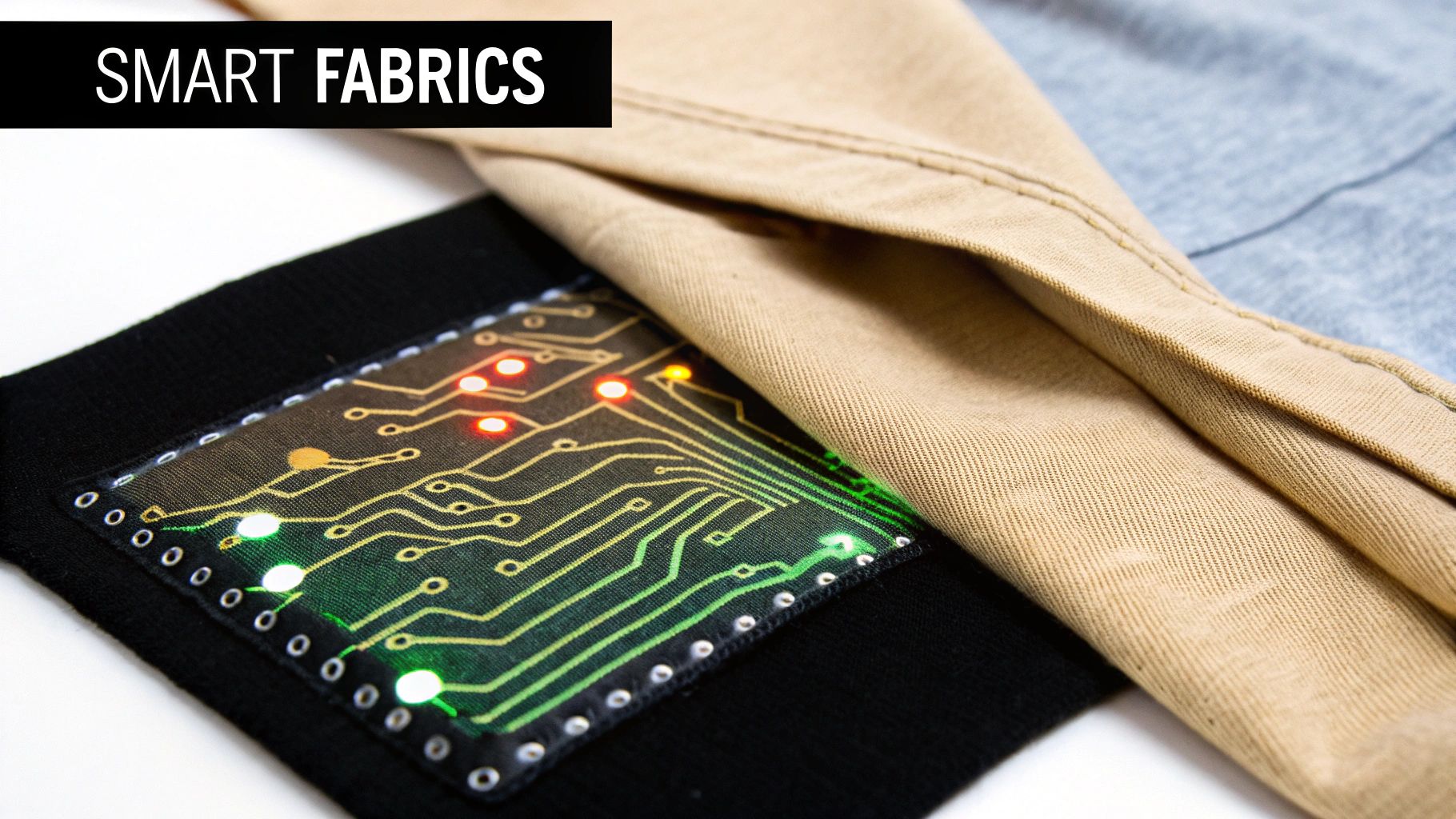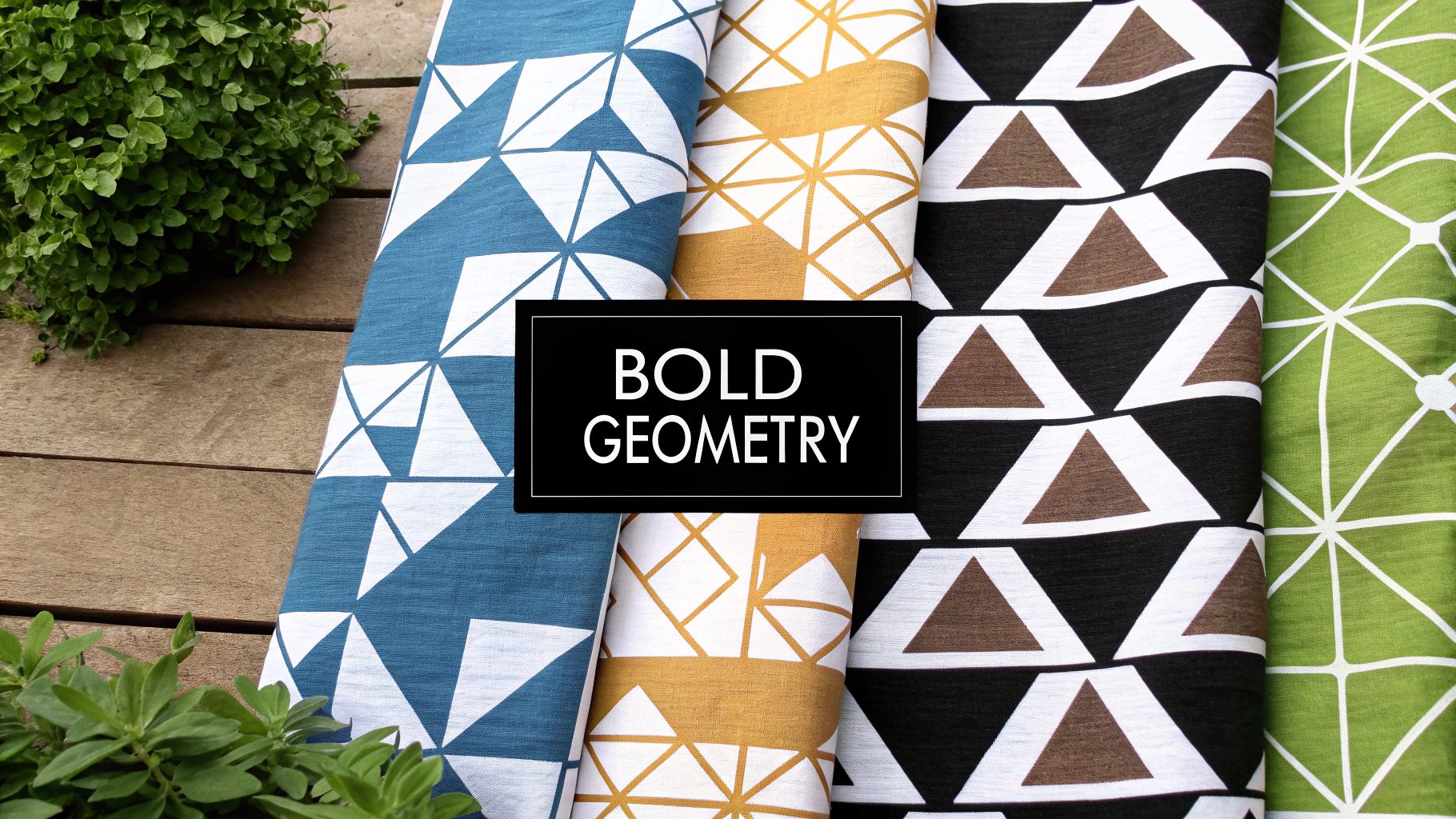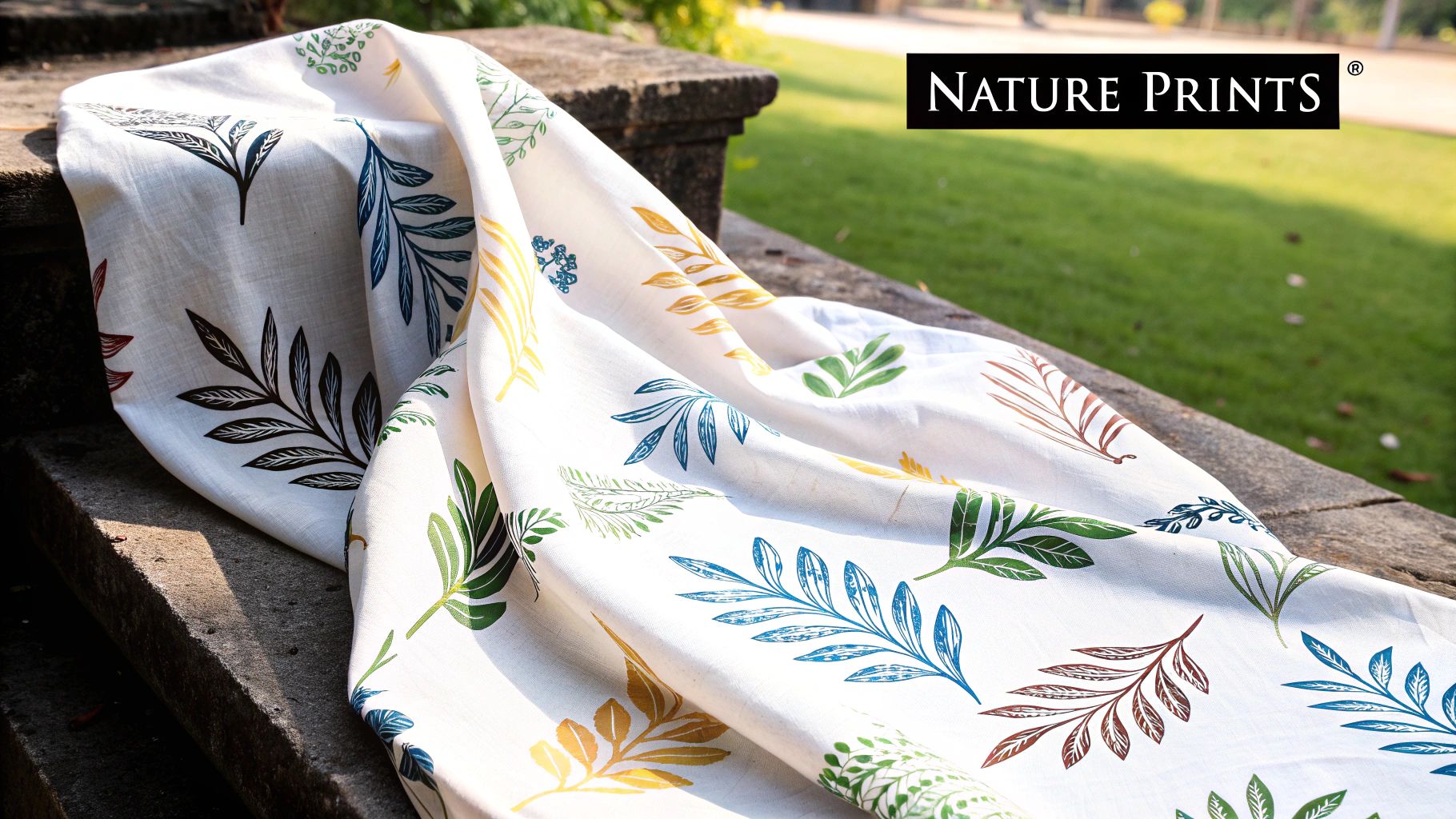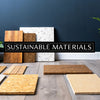Top Textile Design Ideas to Transform Your Interiors

Unveiling the Power of Textile Design
Textiles define the atmosphere of a space, injecting personality and style into interiors. From residential homes to commercial properties, the right textile design can transform a vision into reality. This curated list of 9 textile design ideas offers practical inspiration for various applications across New Zealand and Australia. Discover innovative approaches and fresh perspectives to elevate your interior design projects.
This listicle provides valuable insights into:
- Sustainable textile choices: Learn about eco-friendly materials and ethical sourcing for conscious design.
- Technological advancements: Explore digital print technologies and the potential of smart textiles.
- Creative pattern applications: Discover how geometric, abstract, botanical, and vintage patterns can enhance different spaces.
- Color and texture interplay: Master minimalist schemes, color blocking, and textural innovations for impactful design.
- Cultural influences: Integrate ethnic motifs and cultural elements for unique and personalized interiors.
Whether you're an interior designer, architect, DIY enthusiast, or simply seeking to refresh your home, this collection of textile design ideas will empower you to create stunning and functional spaces. Explore these diverse concepts and discover the transformative power of textiles.
1. Sustainable and Eco-Friendly Textiles
Incorporating sustainable and eco-friendly textiles is a crucial design choice for environmentally conscious projects. This approach prioritizes materials and processes that minimize environmental impact, responding to the increasing demand for ethical and responsible design. It involves sourcing organic fibers, recycled materials, and low-impact dyes, ultimately reducing the textile industry's footprint. This resonates particularly well in eco-conscious markets like New Zealand and Australia.

By embracing sustainable textile design ideas, you contribute to a healthier planet and appeal to a growing segment of consumers who value ethical practices. This approach isn't just a trend; it's a necessary shift towards responsible design and consumption. From homeowners to commercial developers, considering the environmental impact of textile choices is becoming paramount. Learn more about sustainable choices like linen.
Examples of Sustainable Textiles in Action:
- Patagonia: Utilizes recycled polyester derived from plastic bottles, demonstrating a commitment to circularity.
- Eileen Fisher: Champions organic cotton and linen collections, emphasizing natural and renewable resources.
- Stella McCartney: Known for pioneering innovative materials like mushroom leather alternatives, showcasing a dedication to cruelty-free and eco-friendly design.
Implementing Sustainable Textile Design:
- Source Responsibly: Thoroughly research suppliers to ensure authentic sustainability claims and transparent practices.
- Consider Lifecycle: Evaluate the entire lifecycle of the textile, from production and use to eventual disposal or recycling.
- Explore Natural Dyes: Experiment with natural dye techniques using plant-based and mineral dyes for richer, more environmentally friendly color palettes.
- Prioritize Durability: Invest in high-quality, durable textiles to offset the potentially higher initial costs of sustainable materials.
- Communicate Effectively: Share the sustainability story of your chosen textiles with clients and consumers, highlighting the environmental benefits. This transparency resonates with eco-conscious audiences.
2. Digital Print and Smart Textiles
Digital print and smart textiles represent a revolutionary intersection of design and technology. This innovative approach combines digital printing technology with smart materials to create interactive and responsive fabrics. These textiles can dynamically change color, conduct electricity, monitor health metrics, or even respond to environmental conditions, blurring the lines between fashion, technology, and functionality. This offers exciting possibilities for interior design, from dynamic lighting solutions to responsive upholstery.

By integrating smart technology, textiles transcend their traditional decorative role and become active participants in the user experience. Imagine curtains that automatically adjust light transmission based on the time of day, or carpets that monitor foot traffic patterns. This offers exciting new dimensions for both residential and commercial spaces in markets like New Zealand and Australia, driving innovation and personalized experiences. Learn more about digital fabric printing.
Examples of Smart Textiles in Action:
- Google's Project Jacquard: This technology integrates conductive yarns into fabrics, allowing touch and gesture interaction.
- Nike's Dri-FIT: This moisture-wicking fabric enhances athletic performance by keeping the wearer dry and comfortable.
- Under Armour's Temperature-Regulating Fabrics: These smart textiles help maintain optimal body temperature during exercise.
Implementing Digital Print and Smart Textiles:
- Start Simple: Begin with simple integrations of digital print and smart materials before tackling complex electronics.
- Durability First: Consider washability and durability from the initial design phase.
- Collaborate: Partner with technology companies to leverage their expertise in smart materials and electronics.
- User-Centric Design: Focus on solving real user problems and enhancing functionality.
- Rigorous Testing: Conduct extensive testing for comfort, performance, and long-term reliability.
3. Geometric and Abstract Patterns
Geometric and abstract patterns offer a timeless design approach, bringing mathematical precision and artistic abstraction to textiles. Utilizing shapes, lines, and forms, these patterns create visual impact through repetition, symmetry, and bold contrasts. This versatile style suits various applications, from cushions and upholstery to curtains and even fashion accessories, making it a powerful tool for interior designers and DIY enthusiasts alike. The inherent versatility of geometric and abstract patterns allows them to seamlessly integrate into various design schemes, from minimalist and modern to maximalist and eclectic. This adaptability makes them a valuable asset in textile design.

From the bold geometrics of Marimekko, popularized by Maija Isola, to the iconic scarf designs of Hermès, geometric and abstract patterns have consistently captivated designers and consumers. The influence of movements like the Bauhaus school and the Memphis Group further cemented their place in design history, showcasing their enduring appeal. Learn more about geometric patterns. These patterns resonate particularly well in design-forward markets like New Zealand and Australia.
Examples of Geometric and Abstract Patterns in Action:
- Marimekko: Known for vibrant, large-scale floral and geometric prints that add a touch of boldness to any space.
- Hermès: Utilizes intricate geometric designs in their luxurious silk scarves, demonstrating the elegance and sophistication of this style.
- Bauhaus Textiles: Emphasize functional design and geometric abstraction, influencing modern textile design principles.
Implementing Geometric and Abstract Patterns:
- Rule of Thirds: Apply the rule of thirds for visually appealing pattern placement within a space.
- Balance and Contrast: Pair busy patterns with solid colors to create a harmonious balance and prevent visual overload.
- Scale Considerations: Consider the viewing distance when sizing elements within the pattern to ensure optimal impact.
- Real-World Testing: Test patterns at actual use scale to accurately assess their appearance and impact in the intended environment.
- Line Weight Variation: Vary line weights within the pattern to add depth and visual interest. This can enhance the overall texture and dynamism of the design.
4. Botanical and Nature-Inspired Designs
Textile designs inspired by nature offer a refreshing and timeless approach to interior design. This style incorporates flora, fauna, and organic forms, creating a connection with the natural world and fostering calming, harmonious spaces. From delicate floral prints to bold leaf patterns, these designs can transform residential and commercial environments. This resonates particularly well in markets like New Zealand and Australia, where appreciation for natural beauty is deeply ingrained.

Botanical and nature-inspired textile design ideas offer a versatile way to enhance interiors. They can be applied to various elements, including upholstery, curtains, cushions, and wall coverings. Learn more about botanical cushions. This approach adds a touch of organic elegance and creates a sense of tranquility.
Examples of Botanical Textiles in Action:
- Liberty London: Known for its iconic floral prints, often featuring intricate details and vibrant colors.
- William Morris: A pioneer of the Arts and Crafts movement, whose botanical patterns continue to inspire contemporary textile designers.
- Josef Frank: Celebrated for his whimsical and colorful nature-inspired designs, often incorporating a mix of flora and fauna.
Implementing Botanical Textile Design:
- Study Nature: Observe real plants and flowers to capture authentic details and textures.
- Photography for Accuracy: Use photographs as references for color accuracy and to understand light and shadow.
- Consider Scale: Pay attention to the scale relationships between elements to create a balanced composition.
- Balance and Space: Balance detailed areas with simpler spaces to avoid visual clutter.
- Color Palette: Choose a color palette that aligns with the intended mood and purpose of the space.
5. Minimalist and Monochromatic Schemes
Minimalist and monochromatic schemes in textile design emphasize simplicity, clean lines, and limited color palettes. This approach creates sophisticated and timeless textiles. It focuses on texture, form, and subtle variations within a restricted color range. These textiles beautifully complement modern lifestyles and architectural spaces, particularly popular in New Zealand's design scene.
This design philosophy resonates with the increasing desire for clean, uncluttered aesthetics. It allows the inherent beauty of the materials and the quality of construction to take center stage. Monochromatic schemes create a sense of calm and order, ideal for both residential and commercial interiors.
Examples of Minimalist Textiles in Action:
- Muji: Known for its neutral textile collections, emphasizing simplicity and functionality.
- Jil Sander: Showcases minimalist fashion textiles that translate seamlessly into interior design.
- Norm Architects: Demonstrates the power of minimalist textile design in creating serene and sophisticated spaces.
Implementing Minimalist and Monochromatic Textile Design:
- Focus on Texture: Introduce visual interest through varied textures like linen, wool, or silk, even within a limited color palette.
- Use High-Quality Materials: Opt for durable and luxurious materials that enhance the minimalist aesthetic. Consider natural fibers like New Zealand wool.
- Pay Attention to Subtle Color Variations: Explore tonal shifts within your chosen color range to create depth and dimension.
- Consider Light and Shadow: The interplay of light and shadow becomes crucial in minimalist design. Observe how light interacts with different textures and colors.
- Balance Proportions Carefully: Achieve a harmonious look by carefully considering the scale and proportion of textile elements within a space.
This approach is particularly effective in creating a sense of calm and spaciousness. It's ideal for smaller spaces or those seeking a clutter-free environment. Monochromatic palettes are also versatile, allowing for easy integration of artwork and accent pieces. By focusing on quality materials and subtle variations, minimalist textile design achieves a timeless elegance that transcends trends.
6. Vintage and Retro Revival Patterns
Textile designs featuring vintage and retro revival patterns reimagine and reinterpret styles from past decades, particularly the 1960s-1980s. This nostalgic approach combines historical authenticity with contemporary sensibilities, creating designs that feel both familiar and fresh. Modern consumers seeking a connection to cultural heritage are drawn to these patterns. This trend resonates strongly with textile design ideas, offering a unique blend of the past and present.
By incorporating vintage and retro revival patterns, designers can evoke a sense of history and character within a space. This approach appeals to a wide range of consumers, from homeowners seeking a touch of nostalgia to commercial developers aiming for a unique aesthetic. The resurgence of these patterns speaks to a desire for timeless design in a fast-paced world.
Examples of Vintage and Retro Revival Patterns in Action:
- Orla Kiely: Known for her distinctive 1970s-inspired patterns featuring bold colors and simple shapes.
- Marc Jacobs: Has incorporated 1980s revival prints in various collections, showcasing a renewed appreciation for the era's vibrant aesthetics.
- Anthropologie: Offers a curated selection of home textiles with vintage-inspired patterns, appealing to consumers seeking a bohemian and eclectic style.
Implementing Vintage and Retro Revival Patterns:
- Research Historical Context: Thorough research ensures authentic interpretations of past styles and avoids cultural misappropriation.
- Update Vintage Patterns: Modernize vintage patterns by incorporating contemporary color palettes and adapting them to current trends.
- Consider Modern Production Techniques: Utilize digital printing and other modern technologies to reproduce vintage patterns with precision and efficiency.
- Balance Nostalgia with Current Trends: Blend retro elements with current design trends to create a look that's both nostalgic and contemporary.
- Respect Cultural Origins: Acknowledge and respect the cultural origins of the patterns being revived, ensuring sensitive and appropriate use. This is particularly important in diverse markets like New Zealand and Australia.
7. Cultural and Ethnic Motifs
Incorporating cultural and ethnic motifs into textile design offers a powerful way to infuse interiors with unique character and storytelling. This approach draws inspiration from traditional patterns, symbols, and artistic traditions from around the world, celebrating diverse heritages and craftsmanship. It's about respectfully weaving cultural narratives into contemporary design, creating spaces that resonate with authenticity and meaning. This approach is particularly relevant in multicultural societies like New Zealand and Australia, where diverse influences enrich the design landscape.
Successfully integrating cultural motifs requires deep respect and understanding. It involves thorough research and ideally, collaboration with the communities whose heritage is being represented. This ensures accurate and sensitive portrayal, avoiding cultural appropriation and promoting respectful dialogue.
Examples of Cultural Motifs in Design:
- Missoni: Known for their vibrant knitwear featuring Italian-inspired geometric patterns, reflecting a rich textile heritage.
- Etro: Celebrated for their use of paisley and other Indian-inspired designs, demonstrating a fusion of cultural influences.
- Pendleton: Creates iconic Native American-inspired blankets, showcasing the beauty of traditional patterns and craftsmanship.
Implementing Cultural Motifs Respectfully:
- Collaborate with Communities: Engage with cultural experts and artisans to ensure authentic representation and avoid misinterpretations.
- Research Thoroughly: Delve into the historical and cultural significance of chosen motifs, understanding their symbolism and meaning.
- Give Credit and Share Profits: Acknowledge the source of inspiration and consider collaborative partnerships that benefit the communities involved.
- Avoid Sacred or Ceremonial Patterns: Respect cultural sensitivities by refraining from using motifs with religious or sacred significance in everyday design contexts.
- Focus on Celebration: Emphasize the beauty and artistry of cultural motifs, celebrating their richness and contribution to the design world. Communicate the cultural story of the textiles to clients and consumers. This transparency adds depth and meaning to the design.
8. Textural and Tactile Innovations
Textural and tactile innovations in textile design prioritize the physical sensation and three-dimensional qualities of materials. This approach goes beyond visual appeal, engaging multiple senses to create rich, layered experiences within interiors. By exploring innovative weaving techniques, mixed materials, and unique surface treatments, designers can evoke a deeper connection with the fabrics used in residential and commercial spaces. This resonates strongly in design-forward markets like New Zealand and Australia where tactile experiences are increasingly valued.
Examples of Textural Innovation:
- Missoni: Known for its signature vibrant knit textures that add depth and visual interest.
- Issey Miyake: Famous for pleating innovations that transform two-dimensional fabrics into dynamic, three-dimensional forms.
- Nuno Corporation: Employs innovative techniques incorporating diverse materials like paper, feathers, and metallic threads to create unexpected textural combinations.
Implementing Textural and Tactile Design:
- Test Durability: Assess the durability and care requirements of textured textiles early in the design process.
- Consider End-Use: Ensure chosen techniques are suitable for the intended application, considering factors like abrasion resistance and cleanability.
- Balance Texture: Strive for a balance between texture, comfort, and functionality to create spaces that are both visually appealing and practical.
- Strategic Placement: Use texture strategically to create focal points, highlight architectural features, or define zones within a space.
- Prototype Extensively: Experiment with various textures and techniques through prototyping before committing to full production. This allows for adjustments and refinements, ensuring the desired tactile experience is achieved.
By focusing on tactile experiences, designers can create environments that are not only visually appealing but also offer a deeper sensory engagement. Textural and tactile innovations transform how people interact with interior spaces, making them more immersive and memorable. This approach adds a unique dimension to textile design ideas, moving beyond the purely decorative to create a truly engaging sensory experience.
9. Color Blocking and Gradient Effects
Color blocking and gradient effects offer dynamic textile design ideas, creating visual impact and movement through distinct blocks of solid colors or smooth transitions. This versatile approach ranges from sharp, contrasting color boundaries to subtle, gradual shifts, suitable for various applications in both fashion and interiors. This technique allows designers to play with color theory and spatial perception, adding depth and interest to any space.
From vibrant cushions to eye-catching wall hangings, color blocking and gradients can transform a room. This technique injects personality into a space, offering a modern and artistic touch that complements various interior styles. The strategic placement of color blocks can even create illusions of larger or smaller spaces, adding a functional element to its aesthetic appeal.
Examples of Color Blocking and Gradients in Action:
- Piet Mondrian's artwork: Inspiring textile designs with its iconic grid-like structure and primary color palette.
- Yves Saint Laurent's Mondrian dress: A classic example of color blocking translated into fashion.
- Memphis Group designs: Showcasing bold and playful color blocking in furniture and textiles.
Implementing Color Blocking and Gradient Effects:
- Use Color Theory: Create harmonious color combinations using complementary, analogous, or triadic color schemes. This ensures a visually pleasing result.
- 60-30-10 Rule: Consider this rule for color distribution: 60% dominant color, 30% secondary color, and 10% accent color. This creates balance.
- Test Lighting: Evaluate color combinations in different lighting conditions to ensure they achieve the desired effect in the intended space.
- Balance and Neutrals: Balance bold color blocks with neutral areas to avoid overwhelming the eye. This allows the colors to truly pop.
- Psychological Effects: Consider the psychological effects of color choices - warm colors energize, while cool colors soothe. Choose wisely to achieve the desired ambiance.
Creative Textile Design Ideas Comparison
| Design Approach | Implementation Complexity 🔄 | Resource Requirements ⚡ | Expected Outcomes 📊 | Ideal Use Cases 💡 | Key Advantages ⭐ |
|---|---|---|---|---|---|
| Sustainable and Eco-Friendly Textiles | Medium - requires supply chain vetting and closed-loop systems | Moderate - organic/recycled materials, low-impact dyes | Reduced environmental impact, ethical appeal | Ethical fashion, eco-conscious markets | Eco-friendly, unique textures, supports farming |
| Digital Print and Smart Textiles | High - integration of electronics and tech materials | High - conductive fibers, sensors, tech partnership | Interactive, customizable, future-forward | Wearables, athletic wear, tech-integrated fashion | Infinite design options, functionality |
| Geometric and Abstract Patterns | Low - digital or manual pattern creation | Low - standard textile production | Timeless visual impact, versatile | Fashion, home décor, accessories | Easy coordination, strong visual presence |
| Botanical and Nature-Inspired Designs | Medium - detailed organic motifs | Medium - varied natural colors and textures | Calming, harmonizing environments | Fashion, interiors, biophilic design | Connects with nature, calming aesthetic |
| Minimalist and Monochromatic Schemes | Low - simple color palettes, clean designs | Low - limited colors, focus on material quality | Sophisticated, timeless, complements any space | Modern lifestyles, architectural spaces | Versatile, highlights material quality |
| Vintage and Retro Revival Patterns | Medium - requires historical research and digital/print update | Medium - era-specific colors and motifs | Nostalgic, culturally rich | Nostalgia markets, cultural heritage fashion | Emotional connection, unique market positioning |
| Cultural and Ethnic Motifs | High - deep cultural research and respectful design | Medium - traditional production methods | Authentic, educational, diverse market appeal | Cultural celebrations, educational contexts | Rich heritage, unique aesthetics |
| Textural and Tactile Innovations | High - advanced weaving, mixed materials | High - specialized techniques and materials | Multi-sensory experience, added depth | Luxury markets, fashion innovation | Sensory rich, differentiates products |
| Color Blocking and Gradient Effects | Medium - precise color placement and transitions | Low to Medium - depends on dyeing/printing | Bold, dynamic visual impact | Modern fashion, interiors, statement pieces | Strong impact, versatile with color theory |
Bringing Your Textile Visions to Life
From the eco-conscious embrace of sustainable materials to the technological frontier of smart textiles, this exploration of textile design ideas has unveiled a spectrum of possibilities for transforming residential and commercial spaces. We've delved into the vibrant world of botanical prints, the timeless appeal of vintage patterns, the dynamic energy of geometric designs, and the subtle sophistication of minimalist schemes. Each approach offers a unique lens through which to view the power of textiles in shaping our environments.
Key Takeaways and Actionable Steps
Mastering the art of textile selection goes beyond mere aesthetics. It's about understanding the interplay of color, texture, pattern, and material to create spaces that resonate with functionality and style. Here’s a recap of key takeaways to guide your next project:
- Sustainability: Prioritize eco-friendly materials and production methods to minimize environmental impact. Look for certifications and consider the lifecycle of your chosen textiles.
- Innovation: Explore the potential of digital printing and smart textiles to push creative boundaries and enhance functionality. Consider incorporating interactive elements or personalized designs.
- Cultural Significance: Embrace cultural and ethnic motifs to add depth and storytelling to your interiors. Research the origins and significance of patterns before incorporating them into your designs.
- Tactile Experiences: Don't overlook the importance of texture. Incorporate tactile elements to create a multi-sensory experience that engages the touch as well as the sight.
- Color Mastery: Experiment with color blocking and gradient effects to add visual interest and manipulate the perception of space. Consider the psychological impact of color and how it aligns with the intended mood of the room.
The Power of Textile Design in New Zealand and Australia
By understanding these core principles, you can elevate your interiors from simply decorated to truly designed. Whether you’re crafting a cozy haven in a Queenstown villa or a vibrant commercial space in Sydney, the right textile choices can transform the atmosphere and elevate the user experience. Consider the specific needs of your region. In New Zealand and Australia, embracing natural light and incorporating elements of the local landscape can further enhance the impact of your textile choices.
Transforming Vision into Reality
Textiles are more than just coverings; they’re storytellers, mood setters, and expressions of personal style. They have the power to breathe life into a space, reflecting the personality of its inhabitants and the purpose it serves. As you embark on your next design project, remember the diverse world of textile design ideas at your fingertips.
For bespoke textile solutions tailored to your unique vision, explore the offerings of Maak Home. Specializing in custom, sustainable, and digitally printed textiles, Maak Home can help you bring your design dreams to life in New Zealand. Discover the perfect blend of artistry and innovation to transform your space.









